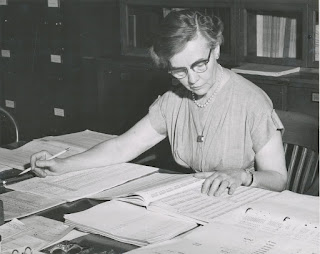By Elizabeth Landau, for Smithsonian Magazine
| Charlotte Moore Sitterly working at her desk at the National Bureau of Standards in Washington, D.C. Image Credit: Michael Duncan via the M.D. Moore Family |
Charlotte Moore could smell the coal burning in the furnace below her back-room workspace at the Princeton University Observatory. With a meager starting salary of $100 per month, she worked as a “computer” for the famous astronomer Henry Norris Russell, helping with calculations to describe how stars evolve and what kinds of materials burn inside them. Her boss’s mind seemed to run too quickly for anyone to follow, and the short, quiet woman he hired fresh out of college in 1920 was initially overwhelmed.
“I felt that he must think that I was the most ignorant person that ever showed up at his house,” she told space historian David DeVorkin in 1978.
At a time when few women had opportunities in the physical sciences, and fewer still received recognition for their efforts, Charlotte Moore Sitterly, as she was known after her marriage, was a pioneer in a field that has touched nearly all scientific disciplines: spectroscopy.
Read more about the woman who worked tirelessly for decades to measure the makeup of the sun and the stars at


